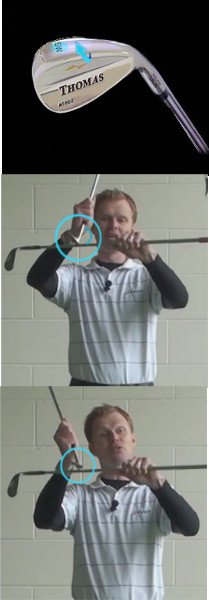You're Correct!
 Lets start by saying that bounce is your friend as it provides forgiveness in contact with the ground when playing wedge shots. Bounce is the angle between the leading edge of the club and the lowest point on the sole.
Lets start by saying that bounce is your friend as it provides forgiveness in contact with the ground when playing wedge shots. Bounce is the angle between the leading edge of the club and the lowest point on the sole.
If you take a look at a wedge you will see that the back edge of the sole is lower than the leading edge. The bigger the difference between the leading edge and the lowest point of the sole will equate to more bounce. The bounce on the wedge allows the club to bruise the turf rather than digging in to the ground too steeply. If a wedge had no bounce, the leading edge of the club would stick sharply into the ground.
So how much bounce should you have on your wedges? When club fitting to find the right amount of bounce for each player, you need to find out how you swing the club. Most players will fall in to one of three categories, a slider, neutral or a digger. The slider has a shallow attack angle and the player will not need much bounce on their wedges. The neutral player has a slightly downward attack and a standard bounce angle would be recommended. The player who is a digger is quite steep into the ball and would benefit from a high amount of bounce.
Ground conditions also have a big factor in determining the amount of bounce you need on a wedge. If you play on hard ground like a links course, high bounce could be detrimental to your wedge play. You will benefit from using a low bounce when playing on firm fairways and sand, and vice-a-versa, a high bounce when playing on soft lush ground conditions.
Most wedges also have varying grinds on the sole. The con touring on the sole allows for shot making opportunities, allowing the player to open and close the face without affecting the amount of bounce.
Wedges are not one size fits all, so find a professional club fitter to get you fitted for the right amount of bounce you need on your wedges. It will really benefit your wedge game.
Sorry Try Again! - See Explanation Below
When referring to bounce on a wedge, this is the difference between the leading edge of the club and the lowest point on the sole. The height the ball bounces upon landing is down to the firmness of the ground and trajectory the ball is landing on.
Sorry Try Again! - See Explanation Below
The camber between the toe and heel on a wedge is known as the grind. This con touring on the toe and heel of the wedge allows for greater shot making opportunities around the greens. The heel and toe relief allows the player to open and close the club face without affecting the wedges bounce angle too much.
Sorry Try Again! - See Explanation Below
When playing chip and pitch shots, you ideally should see a bruising of the turf rather than digging a big loaf of bread sized divot out from under the ball. If your divots are too big, you either have too little bounce on your wedges or you need to improve your technique.







